Emotional Intelligence: Critical Analysis of Five Articles
VerifiedAdded on 2023/03/20
|18
|4049
|30
AI Summary
This article provides a critical analysis of five articles on emotional intelligence, discussing its importance in various fields and highlighting the different models and tests used to measure it.
Contribute Materials
Your contribution can guide someone’s learning journey. Share your
documents today.
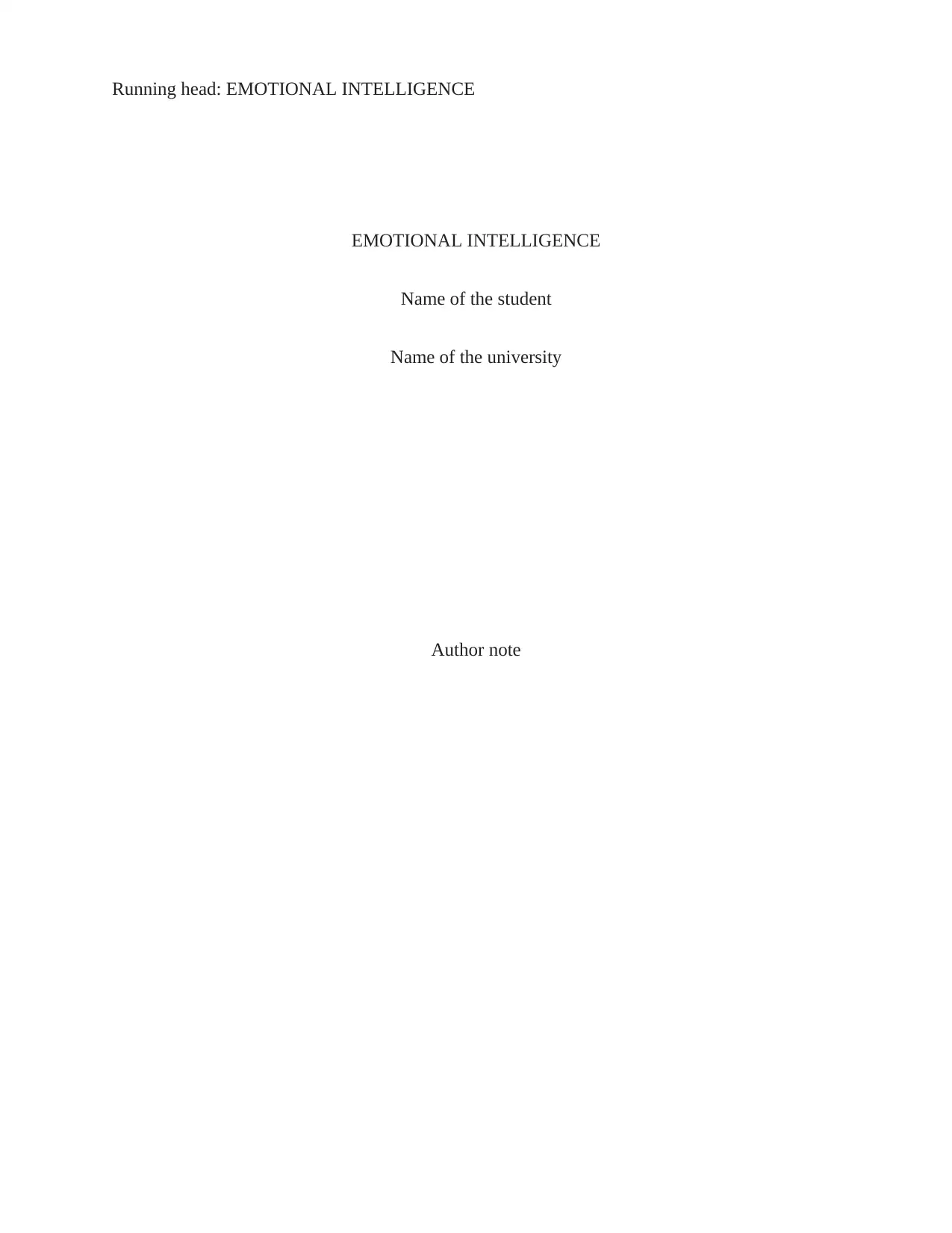
Running head: EMOTIONAL INTELLIGENCE
EMOTIONAL INTELLIGENCE
Name of the student
Name of the university
Author note
EMOTIONAL INTELLIGENCE
Name of the student
Name of the university
Author note
Secure Best Marks with AI Grader
Need help grading? Try our AI Grader for instant feedback on your assignments.
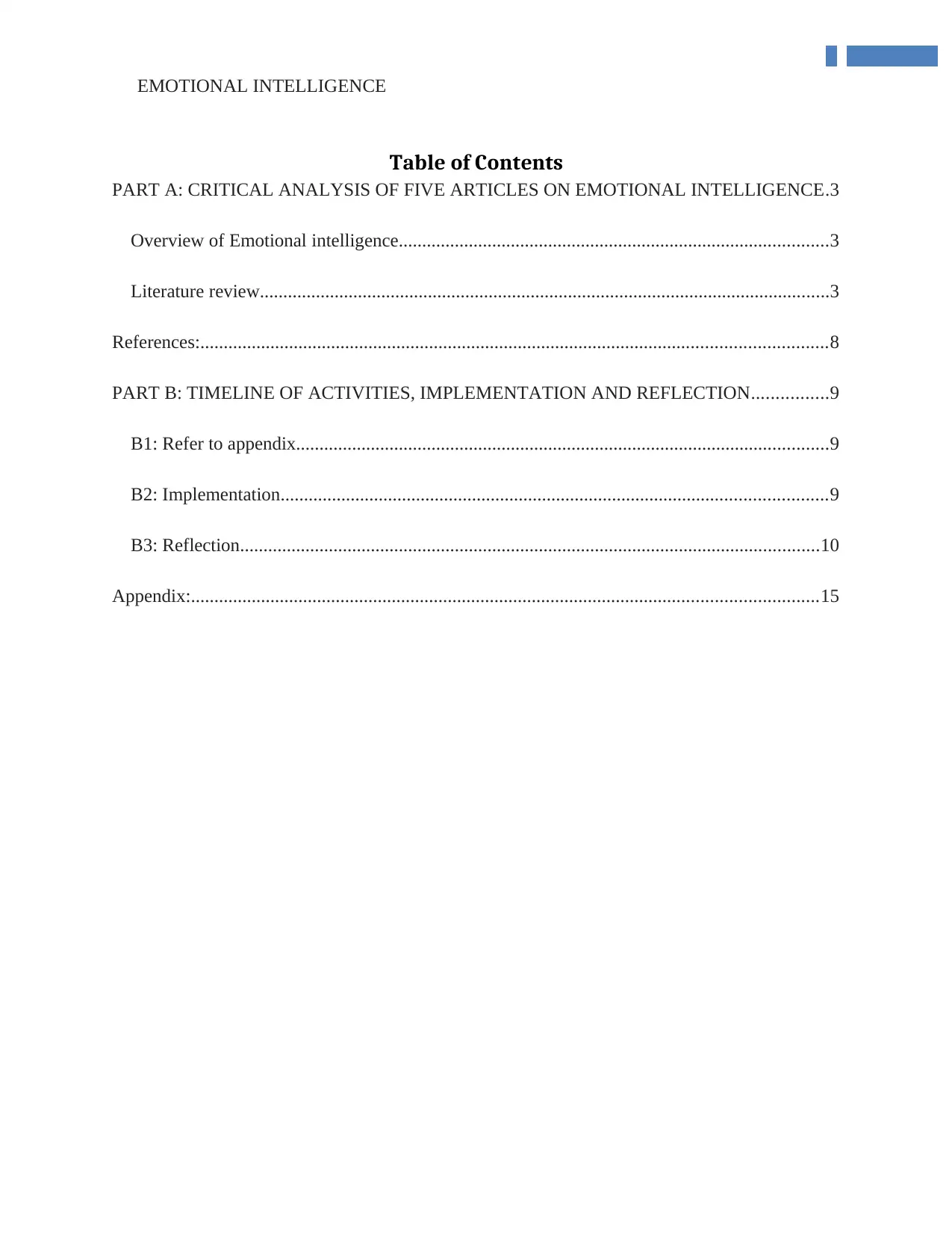
1
EMOTIONAL INTELLIGENCE
Table of Contents
PART A: CRITICAL ANALYSIS OF FIVE ARTICLES ON EMOTIONAL INTELLIGENCE.3
Overview of Emotional intelligence............................................................................................3
Literature review..........................................................................................................................3
References:......................................................................................................................................8
PART B: TIMELINE OF ACTIVITIES, IMPLEMENTATION AND REFLECTION................9
B1: Refer to appendix..................................................................................................................9
B2: Implementation.....................................................................................................................9
B3: Reflection............................................................................................................................10
Appendix:......................................................................................................................................15
EMOTIONAL INTELLIGENCE
Table of Contents
PART A: CRITICAL ANALYSIS OF FIVE ARTICLES ON EMOTIONAL INTELLIGENCE.3
Overview of Emotional intelligence............................................................................................3
Literature review..........................................................................................................................3
References:......................................................................................................................................8
PART B: TIMELINE OF ACTIVITIES, IMPLEMENTATION AND REFLECTION................9
B1: Refer to appendix..................................................................................................................9
B2: Implementation.....................................................................................................................9
B3: Reflection............................................................................................................................10
Appendix:......................................................................................................................................15
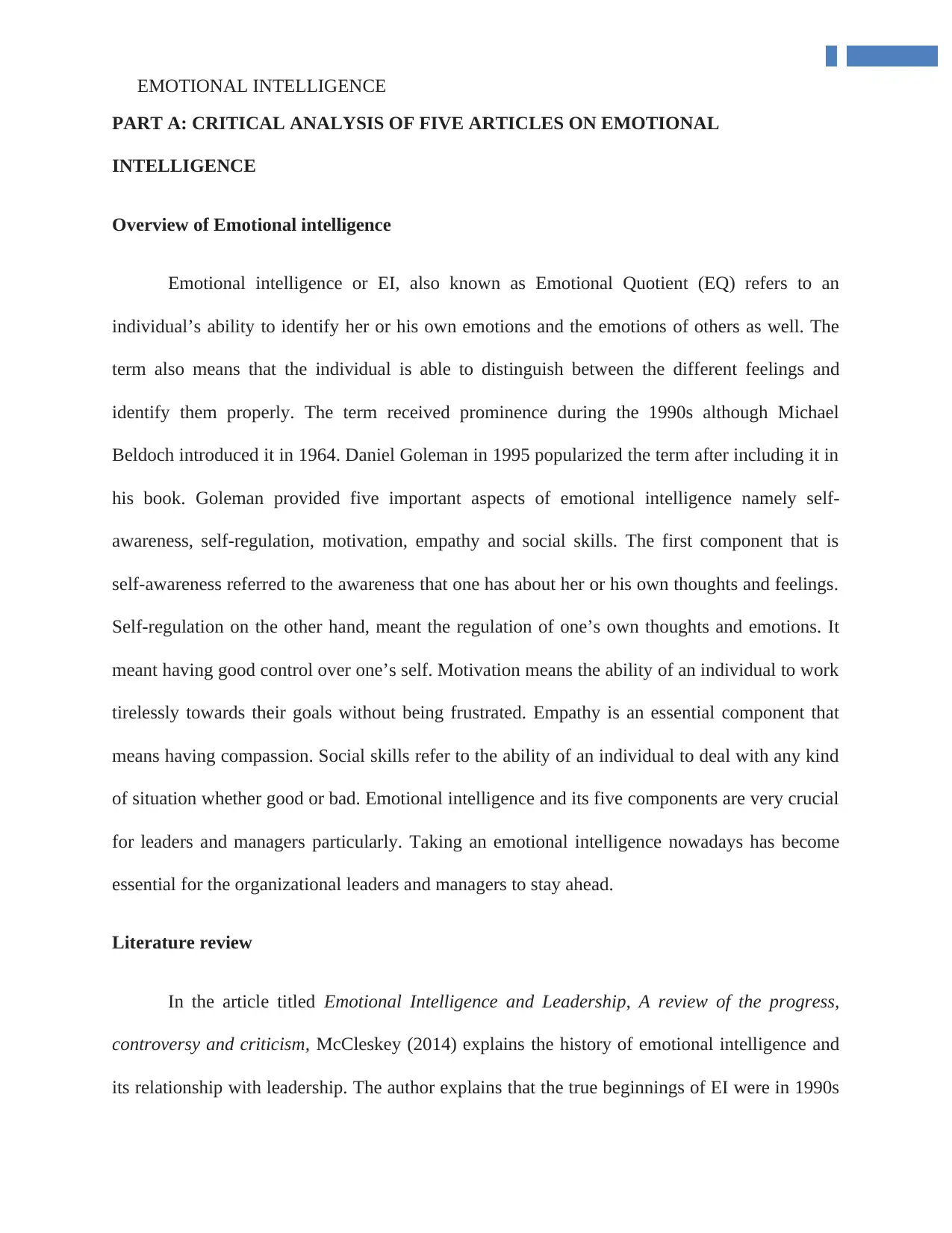
2
EMOTIONAL INTELLIGENCE
PART A: CRITICAL ANALYSIS OF FIVE ARTICLES ON EMOTIONAL
INTELLIGENCE
Overview of Emotional intelligence
Emotional intelligence or EI, also known as Emotional Quotient (EQ) refers to an
individual’s ability to identify her or his own emotions and the emotions of others as well. The
term also means that the individual is able to distinguish between the different feelings and
identify them properly. The term received prominence during the 1990s although Michael
Beldoch introduced it in 1964. Daniel Goleman in 1995 popularized the term after including it in
his book. Goleman provided five important aspects of emotional intelligence namely self-
awareness, self-regulation, motivation, empathy and social skills. The first component that is
self-awareness referred to the awareness that one has about her or his own thoughts and feelings.
Self-regulation on the other hand, meant the regulation of one’s own thoughts and emotions. It
meant having good control over one’s self. Motivation means the ability of an individual to work
tirelessly towards their goals without being frustrated. Empathy is an essential component that
means having compassion. Social skills refer to the ability of an individual to deal with any kind
of situation whether good or bad. Emotional intelligence and its five components are very crucial
for leaders and managers particularly. Taking an emotional intelligence nowadays has become
essential for the organizational leaders and managers to stay ahead.
Literature review
In the article titled Emotional Intelligence and Leadership, A review of the progress,
controversy and criticism, McCleskey (2014) explains the history of emotional intelligence and
its relationship with leadership. The author explains that the true beginnings of EI were in 1990s
EMOTIONAL INTELLIGENCE
PART A: CRITICAL ANALYSIS OF FIVE ARTICLES ON EMOTIONAL
INTELLIGENCE
Overview of Emotional intelligence
Emotional intelligence or EI, also known as Emotional Quotient (EQ) refers to an
individual’s ability to identify her or his own emotions and the emotions of others as well. The
term also means that the individual is able to distinguish between the different feelings and
identify them properly. The term received prominence during the 1990s although Michael
Beldoch introduced it in 1964. Daniel Goleman in 1995 popularized the term after including it in
his book. Goleman provided five important aspects of emotional intelligence namely self-
awareness, self-regulation, motivation, empathy and social skills. The first component that is
self-awareness referred to the awareness that one has about her or his own thoughts and feelings.
Self-regulation on the other hand, meant the regulation of one’s own thoughts and emotions. It
meant having good control over one’s self. Motivation means the ability of an individual to work
tirelessly towards their goals without being frustrated. Empathy is an essential component that
means having compassion. Social skills refer to the ability of an individual to deal with any kind
of situation whether good or bad. Emotional intelligence and its five components are very crucial
for leaders and managers particularly. Taking an emotional intelligence nowadays has become
essential for the organizational leaders and managers to stay ahead.
Literature review
In the article titled Emotional Intelligence and Leadership, A review of the progress,
controversy and criticism, McCleskey (2014) explains the history of emotional intelligence and
its relationship with leadership. The author explains that the true beginnings of EI were in 1990s
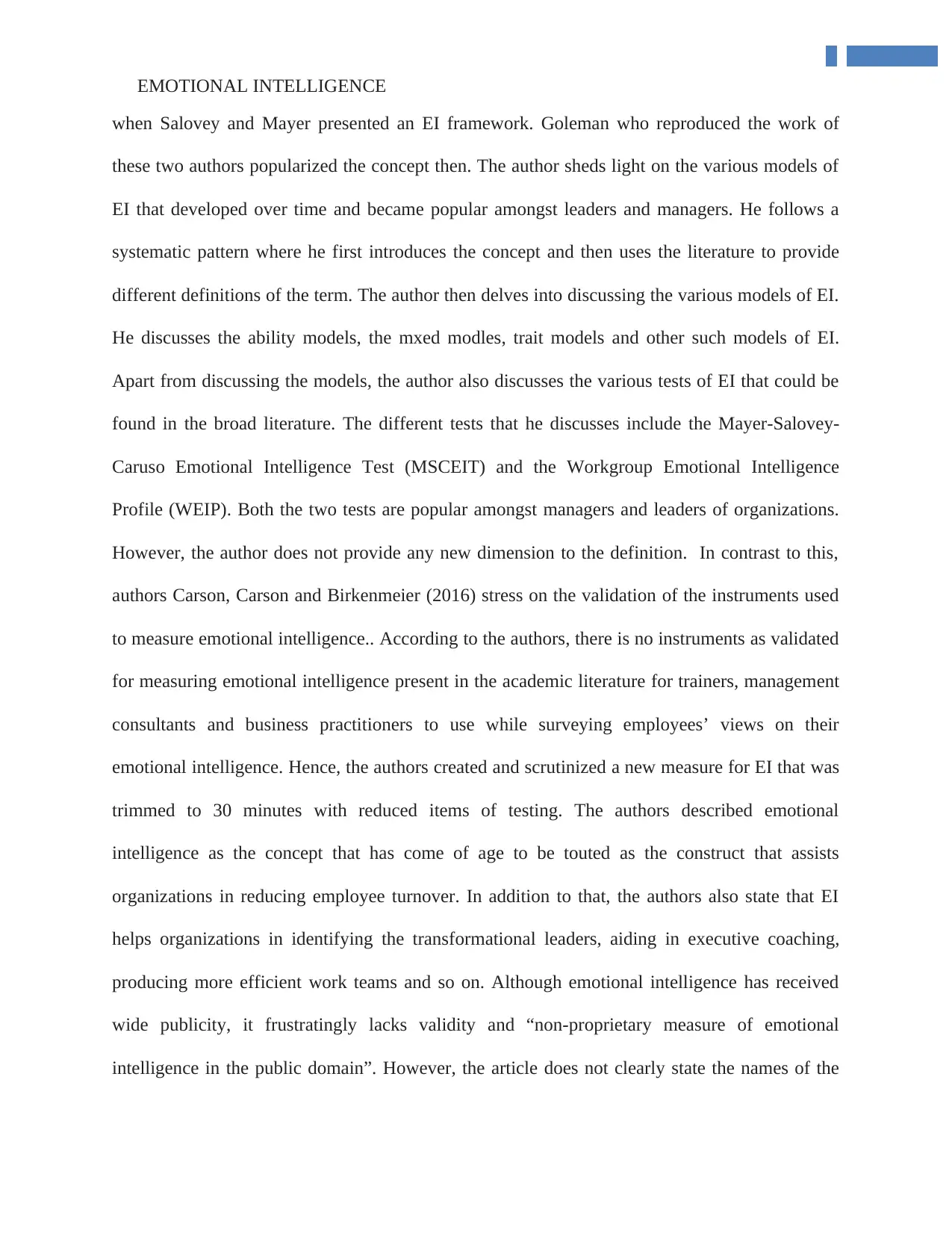
3
EMOTIONAL INTELLIGENCE
when Salovey and Mayer presented an EI framework. Goleman who reproduced the work of
these two authors popularized the concept then. The author sheds light on the various models of
EI that developed over time and became popular amongst leaders and managers. He follows a
systematic pattern where he first introduces the concept and then uses the literature to provide
different definitions of the term. The author then delves into discussing the various models of EI.
He discusses the ability models, the mxed modles, trait models and other such models of EI.
Apart from discussing the models, the author also discusses the various tests of EI that could be
found in the broad literature. The different tests that he discusses include the Mayer-Salovey-
Caruso Emotional Intelligence Test (MSCEIT) and the Workgroup Emotional Intelligence
Profile (WEIP). Both the two tests are popular amongst managers and leaders of organizations.
However, the author does not provide any new dimension to the definition. In contrast to this,
authors Carson, Carson and Birkenmeier (2016) stress on the validation of the instruments used
to measure emotional intelligence.. According to the authors, there is no instruments as validated
for measuring emotional intelligence present in the academic literature for trainers, management
consultants and business practitioners to use while surveying employees’ views on their
emotional intelligence. Hence, the authors created and scrutinized a new measure for EI that was
trimmed to 30 minutes with reduced items of testing. The authors described emotional
intelligence as the concept that has come of age to be touted as the construct that assists
organizations in reducing employee turnover. In addition to that, the authors also state that EI
helps organizations in identifying the transformational leaders, aiding in executive coaching,
producing more efficient work teams and so on. Although emotional intelligence has received
wide publicity, it frustratingly lacks validity and “non-proprietary measure of emotional
intelligence in the public domain”. However, the article does not clearly state the names of the
EMOTIONAL INTELLIGENCE
when Salovey and Mayer presented an EI framework. Goleman who reproduced the work of
these two authors popularized the concept then. The author sheds light on the various models of
EI that developed over time and became popular amongst leaders and managers. He follows a
systematic pattern where he first introduces the concept and then uses the literature to provide
different definitions of the term. The author then delves into discussing the various models of EI.
He discusses the ability models, the mxed modles, trait models and other such models of EI.
Apart from discussing the models, the author also discusses the various tests of EI that could be
found in the broad literature. The different tests that he discusses include the Mayer-Salovey-
Caruso Emotional Intelligence Test (MSCEIT) and the Workgroup Emotional Intelligence
Profile (WEIP). Both the two tests are popular amongst managers and leaders of organizations.
However, the author does not provide any new dimension to the definition. In contrast to this,
authors Carson, Carson and Birkenmeier (2016) stress on the validation of the instruments used
to measure emotional intelligence.. According to the authors, there is no instruments as validated
for measuring emotional intelligence present in the academic literature for trainers, management
consultants and business practitioners to use while surveying employees’ views on their
emotional intelligence. Hence, the authors created and scrutinized a new measure for EI that was
trimmed to 30 minutes with reduced items of testing. The authors described emotional
intelligence as the concept that has come of age to be touted as the construct that assists
organizations in reducing employee turnover. In addition to that, the authors also state that EI
helps organizations in identifying the transformational leaders, aiding in executive coaching,
producing more efficient work teams and so on. Although emotional intelligence has received
wide publicity, it frustratingly lacks validity and “non-proprietary measure of emotional
intelligence in the public domain”. However, the article does not clearly state the names of the
Secure Best Marks with AI Grader
Need help grading? Try our AI Grader for instant feedback on your assignments.
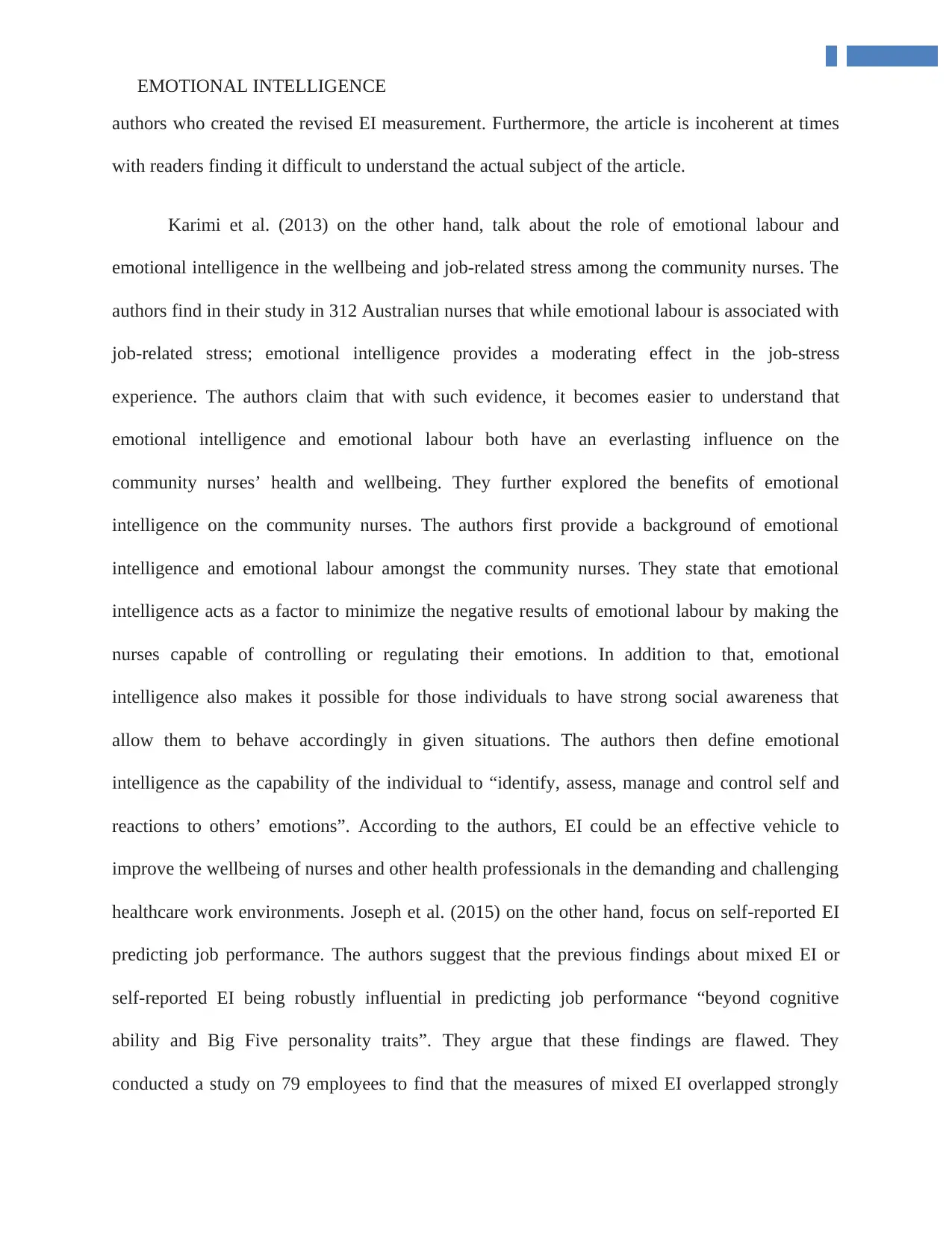
4
EMOTIONAL INTELLIGENCE
authors who created the revised EI measurement. Furthermore, the article is incoherent at times
with readers finding it difficult to understand the actual subject of the article.
Karimi et al. (2013) on the other hand, talk about the role of emotional labour and
emotional intelligence in the wellbeing and job-related stress among the community nurses. The
authors find in their study in 312 Australian nurses that while emotional labour is associated with
job-related stress; emotional intelligence provides a moderating effect in the job-stress
experience. The authors claim that with such evidence, it becomes easier to understand that
emotional intelligence and emotional labour both have an everlasting influence on the
community nurses’ health and wellbeing. They further explored the benefits of emotional
intelligence on the community nurses. The authors first provide a background of emotional
intelligence and emotional labour amongst the community nurses. They state that emotional
intelligence acts as a factor to minimize the negative results of emotional labour by making the
nurses capable of controlling or regulating their emotions. In addition to that, emotional
intelligence also makes it possible for those individuals to have strong social awareness that
allow them to behave accordingly in given situations. The authors then define emotional
intelligence as the capability of the individual to “identify, assess, manage and control self and
reactions to others’ emotions”. According to the authors, EI could be an effective vehicle to
improve the wellbeing of nurses and other health professionals in the demanding and challenging
healthcare work environments. Joseph et al. (2015) on the other hand, focus on self-reported EI
predicting job performance. The authors suggest that the previous findings about mixed EI or
self-reported EI being robustly influential in predicting job performance “beyond cognitive
ability and Big Five personality traits”. They argue that these findings are flawed. They
conducted a study on 79 employees to find that the measures of mixed EI overlapped strongly
EMOTIONAL INTELLIGENCE
authors who created the revised EI measurement. Furthermore, the article is incoherent at times
with readers finding it difficult to understand the actual subject of the article.
Karimi et al. (2013) on the other hand, talk about the role of emotional labour and
emotional intelligence in the wellbeing and job-related stress among the community nurses. The
authors find in their study in 312 Australian nurses that while emotional labour is associated with
job-related stress; emotional intelligence provides a moderating effect in the job-stress
experience. The authors claim that with such evidence, it becomes easier to understand that
emotional intelligence and emotional labour both have an everlasting influence on the
community nurses’ health and wellbeing. They further explored the benefits of emotional
intelligence on the community nurses. The authors first provide a background of emotional
intelligence and emotional labour amongst the community nurses. They state that emotional
intelligence acts as a factor to minimize the negative results of emotional labour by making the
nurses capable of controlling or regulating their emotions. In addition to that, emotional
intelligence also makes it possible for those individuals to have strong social awareness that
allow them to behave accordingly in given situations. The authors then define emotional
intelligence as the capability of the individual to “identify, assess, manage and control self and
reactions to others’ emotions”. According to the authors, EI could be an effective vehicle to
improve the wellbeing of nurses and other health professionals in the demanding and challenging
healthcare work environments. Joseph et al. (2015) on the other hand, focus on self-reported EI
predicting job performance. The authors suggest that the previous findings about mixed EI or
self-reported EI being robustly influential in predicting job performance “beyond cognitive
ability and Big Five personality traits”. They argue that these findings are flawed. They
conducted a study on 79 employees to find that the measures of mixed EI overlapped strongly
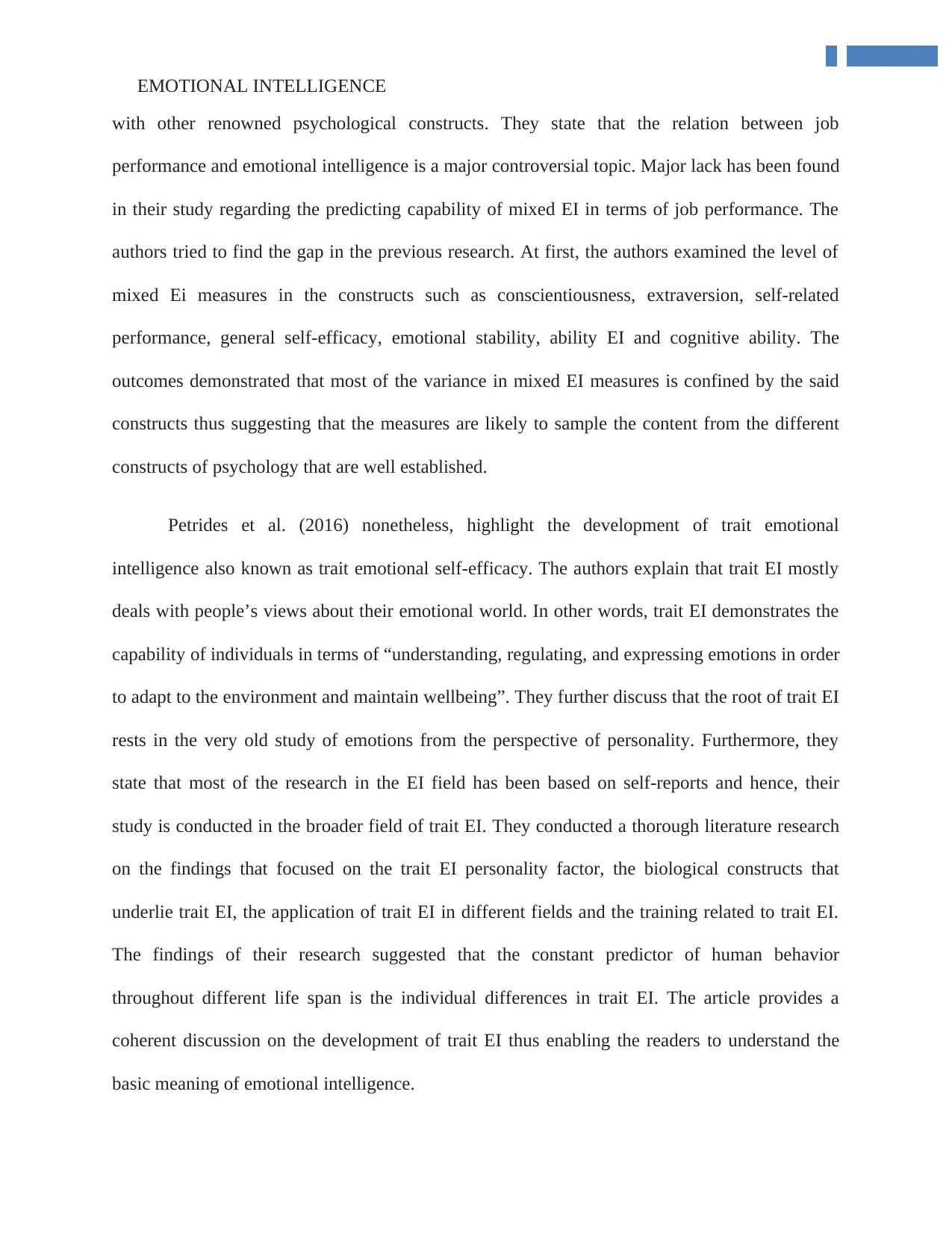
5
EMOTIONAL INTELLIGENCE
with other renowned psychological constructs. They state that the relation between job
performance and emotional intelligence is a major controversial topic. Major lack has been found
in their study regarding the predicting capability of mixed EI in terms of job performance. The
authors tried to find the gap in the previous research. At first, the authors examined the level of
mixed Ei measures in the constructs such as conscientiousness, extraversion, self-related
performance, general self-efficacy, emotional stability, ability EI and cognitive ability. The
outcomes demonstrated that most of the variance in mixed EI measures is confined by the said
constructs thus suggesting that the measures are likely to sample the content from the different
constructs of psychology that are well established.
Petrides et al. (2016) nonetheless, highlight the development of trait emotional
intelligence also known as trait emotional self-efficacy. The authors explain that trait EI mostly
deals with people’s views about their emotional world. In other words, trait EI demonstrates the
capability of individuals in terms of “understanding, regulating, and expressing emotions in order
to adapt to the environment and maintain wellbeing”. They further discuss that the root of trait EI
rests in the very old study of emotions from the perspective of personality. Furthermore, they
state that most of the research in the EI field has been based on self-reports and hence, their
study is conducted in the broader field of trait EI. They conducted a thorough literature research
on the findings that focused on the trait EI personality factor, the biological constructs that
underlie trait EI, the application of trait EI in different fields and the training related to trait EI.
The findings of their research suggested that the constant predictor of human behavior
throughout different life span is the individual differences in trait EI. The article provides a
coherent discussion on the development of trait EI thus enabling the readers to understand the
basic meaning of emotional intelligence.
EMOTIONAL INTELLIGENCE
with other renowned psychological constructs. They state that the relation between job
performance and emotional intelligence is a major controversial topic. Major lack has been found
in their study regarding the predicting capability of mixed EI in terms of job performance. The
authors tried to find the gap in the previous research. At first, the authors examined the level of
mixed Ei measures in the constructs such as conscientiousness, extraversion, self-related
performance, general self-efficacy, emotional stability, ability EI and cognitive ability. The
outcomes demonstrated that most of the variance in mixed EI measures is confined by the said
constructs thus suggesting that the measures are likely to sample the content from the different
constructs of psychology that are well established.
Petrides et al. (2016) nonetheless, highlight the development of trait emotional
intelligence also known as trait emotional self-efficacy. The authors explain that trait EI mostly
deals with people’s views about their emotional world. In other words, trait EI demonstrates the
capability of individuals in terms of “understanding, regulating, and expressing emotions in order
to adapt to the environment and maintain wellbeing”. They further discuss that the root of trait EI
rests in the very old study of emotions from the perspective of personality. Furthermore, they
state that most of the research in the EI field has been based on self-reports and hence, their
study is conducted in the broader field of trait EI. They conducted a thorough literature research
on the findings that focused on the trait EI personality factor, the biological constructs that
underlie trait EI, the application of trait EI in different fields and the training related to trait EI.
The findings of their research suggested that the constant predictor of human behavior
throughout different life span is the individual differences in trait EI. The article provides a
coherent discussion on the development of trait EI thus enabling the readers to understand the
basic meaning of emotional intelligence.

6
EMOTIONAL INTELLIGENCE
The review of literature revealed that emotional intelligence or EI has great significance
in any professional field. The five articles that were particularly reviewed provided a spectrum of
issues related to emotional intelligence. While the article by McCleskey (2014) shed light on the
history of emotional intelligence and its importance in leadership, Karmini et al. (2014) discuss
the importance of emotional intelligence in the nursing profession. On the other hand, Carson,
Carson and Birkenmeier (2016) analyzed the validation of the instruments used to measure
emotional intelligence. Joseph et al. (2015) and Petrides et al. (2016) explained the mixed model
and trait model of EI respectively. In all the articles, the authors first described emotional
intelligence and its popularity in the various fields of educational, health, professional and others.
In the articles, the authors provided an in-depth analysis of the various aspects of emotional
intelligence. However, certain shortcomings could also be discerned in the articles. For instance,
the article by McCleskey did not clearly mention the importance of emotional intelligence in
leadership. The author mostly talked about the different tests and models of the EI. In Carson,
Carson and Birkenmeier’s article, the authors did not clearly mention the name of the authors
who created the initial testing of emotional intelligence. Furthermore, the authors also lacked
some depth in the research related to the validation of instruments to measure EI. On the other
hand, the Karimi et al. article was coherent as it comprehensively explained the importance of EI
in the nursing profession.
EMOTIONAL INTELLIGENCE
The review of literature revealed that emotional intelligence or EI has great significance
in any professional field. The five articles that were particularly reviewed provided a spectrum of
issues related to emotional intelligence. While the article by McCleskey (2014) shed light on the
history of emotional intelligence and its importance in leadership, Karmini et al. (2014) discuss
the importance of emotional intelligence in the nursing profession. On the other hand, Carson,
Carson and Birkenmeier (2016) analyzed the validation of the instruments used to measure
emotional intelligence. Joseph et al. (2015) and Petrides et al. (2016) explained the mixed model
and trait model of EI respectively. In all the articles, the authors first described emotional
intelligence and its popularity in the various fields of educational, health, professional and others.
In the articles, the authors provided an in-depth analysis of the various aspects of emotional
intelligence. However, certain shortcomings could also be discerned in the articles. For instance,
the article by McCleskey did not clearly mention the importance of emotional intelligence in
leadership. The author mostly talked about the different tests and models of the EI. In Carson,
Carson and Birkenmeier’s article, the authors did not clearly mention the name of the authors
who created the initial testing of emotional intelligence. Furthermore, the authors also lacked
some depth in the research related to the validation of instruments to measure EI. On the other
hand, the Karimi et al. article was coherent as it comprehensively explained the importance of EI
in the nursing profession.
Paraphrase This Document
Need a fresh take? Get an instant paraphrase of this document with our AI Paraphraser

7
EMOTIONAL INTELLIGENCE
References:
Carson, K.D., Carson, P.P. and Birkenmeier, B.J., 2016. Measuring emotional intelligence:
Development and validation of an instrument. Journal of Behavioral and applied
Management, 2(1), p.810.
Joseph, D.L., Jin, J., Newman, D.A. and O'boyle, E.H., 2015. Why does self-reported emotional
intelligence predict job performance? A meta-analytic investigation of mixed EI. Journal of
Applied Psychology, 100(2), p.298.
Karimi, L., Leggat, S.G., Donohue, L., Farrell, G. and Couper, G.E., 2014. Emotional rescue:
The role of emotional intelligence and emotional labour on well‐being and job‐stress among
community nurses. Journal of advanced nursing, 70(1), pp.176-186.
McCleskey, J., 2014. Emotional intelligence and leadership: A review of the progress,
controversy, and criticism. International Journal of Organizational Analysis, 22(1), pp.76-93.
Petrides, K.V., Mikolajczak, M., Mavroveli, S., Sanchez-Ruiz, M.J., Furnham, A. and Pérez-
González, J.C., 2016. Developments in trait emotional intelligence research. Emotion
Review, 8(4), pp.335-341.
EMOTIONAL INTELLIGENCE
References:
Carson, K.D., Carson, P.P. and Birkenmeier, B.J., 2016. Measuring emotional intelligence:
Development and validation of an instrument. Journal of Behavioral and applied
Management, 2(1), p.810.
Joseph, D.L., Jin, J., Newman, D.A. and O'boyle, E.H., 2015. Why does self-reported emotional
intelligence predict job performance? A meta-analytic investigation of mixed EI. Journal of
Applied Psychology, 100(2), p.298.
Karimi, L., Leggat, S.G., Donohue, L., Farrell, G. and Couper, G.E., 2014. Emotional rescue:
The role of emotional intelligence and emotional labour on well‐being and job‐stress among
community nurses. Journal of advanced nursing, 70(1), pp.176-186.
McCleskey, J., 2014. Emotional intelligence and leadership: A review of the progress,
controversy, and criticism. International Journal of Organizational Analysis, 22(1), pp.76-93.
Petrides, K.V., Mikolajczak, M., Mavroveli, S., Sanchez-Ruiz, M.J., Furnham, A. and Pérez-
González, J.C., 2016. Developments in trait emotional intelligence research. Emotion
Review, 8(4), pp.335-341.

8
EMOTIONAL INTELLIGENCE
PART B: TIMELINE OF ACTIVITIES, IMPLEMENTATION AND REFLECTION
B1: Refer to appendix
B2: Implementation
The implementation of timeline was quite problematic for me although it was exciting at
the same time as well. I prepared a three-week timeline of activities based mainly on Emotional
Intelligence. The excitement was because I knew I would be engaging in lot of activities that
would help me realize my own emotional intelligence capabilities. the problems that I faced
implementing the timeline was that I was not sure about which activities I should engage in from
week one through week three that could help me learn more about EI. I was confused and hence,
I feel the implementation was not that effective as it should have been. I wanted to engage in
various activities that could help enhance emotional intelligence but due to my inability to
understand the management of time, I was unable to engage in all the activities. Nonetheless, I
was able to engage in many activities including attending seminars on leadership and emotional
intelligence. I found that the qualities of a leader are closely related to the qualities that make an
individual emotionally intelligent. The challenging part in the implementation of the timeline
was to manage the time for attending university classes and visiting local business to learn more
about management and leadership from EI perspective. The interesting part of the
implementation was visiting restaurant and interacting with people. I tried to observe the people
and associate their emotions with my own. This helped me largely in reflecting upon my own
emotions. I also watched films that portrayed emotional intelligence, which further helped to
learn about the topic. Despite the implementation being challenging, difficult and problematic, it
was rewarding because it helped me understand more about the topic. I could state that the
EMOTIONAL INTELLIGENCE
PART B: TIMELINE OF ACTIVITIES, IMPLEMENTATION AND REFLECTION
B1: Refer to appendix
B2: Implementation
The implementation of timeline was quite problematic for me although it was exciting at
the same time as well. I prepared a three-week timeline of activities based mainly on Emotional
Intelligence. The excitement was because I knew I would be engaging in lot of activities that
would help me realize my own emotional intelligence capabilities. the problems that I faced
implementing the timeline was that I was not sure about which activities I should engage in from
week one through week three that could help me learn more about EI. I was confused and hence,
I feel the implementation was not that effective as it should have been. I wanted to engage in
various activities that could help enhance emotional intelligence but due to my inability to
understand the management of time, I was unable to engage in all the activities. Nonetheless, I
was able to engage in many activities including attending seminars on leadership and emotional
intelligence. I found that the qualities of a leader are closely related to the qualities that make an
individual emotionally intelligent. The challenging part in the implementation of the timeline
was to manage the time for attending university classes and visiting local business to learn more
about management and leadership from EI perspective. The interesting part of the
implementation was visiting restaurant and interacting with people. I tried to observe the people
and associate their emotions with my own. This helped me largely in reflecting upon my own
emotions. I also watched films that portrayed emotional intelligence, which further helped to
learn about the topic. Despite the implementation being challenging, difficult and problematic, it
was rewarding because it helped me understand more about the topic. I could state that the
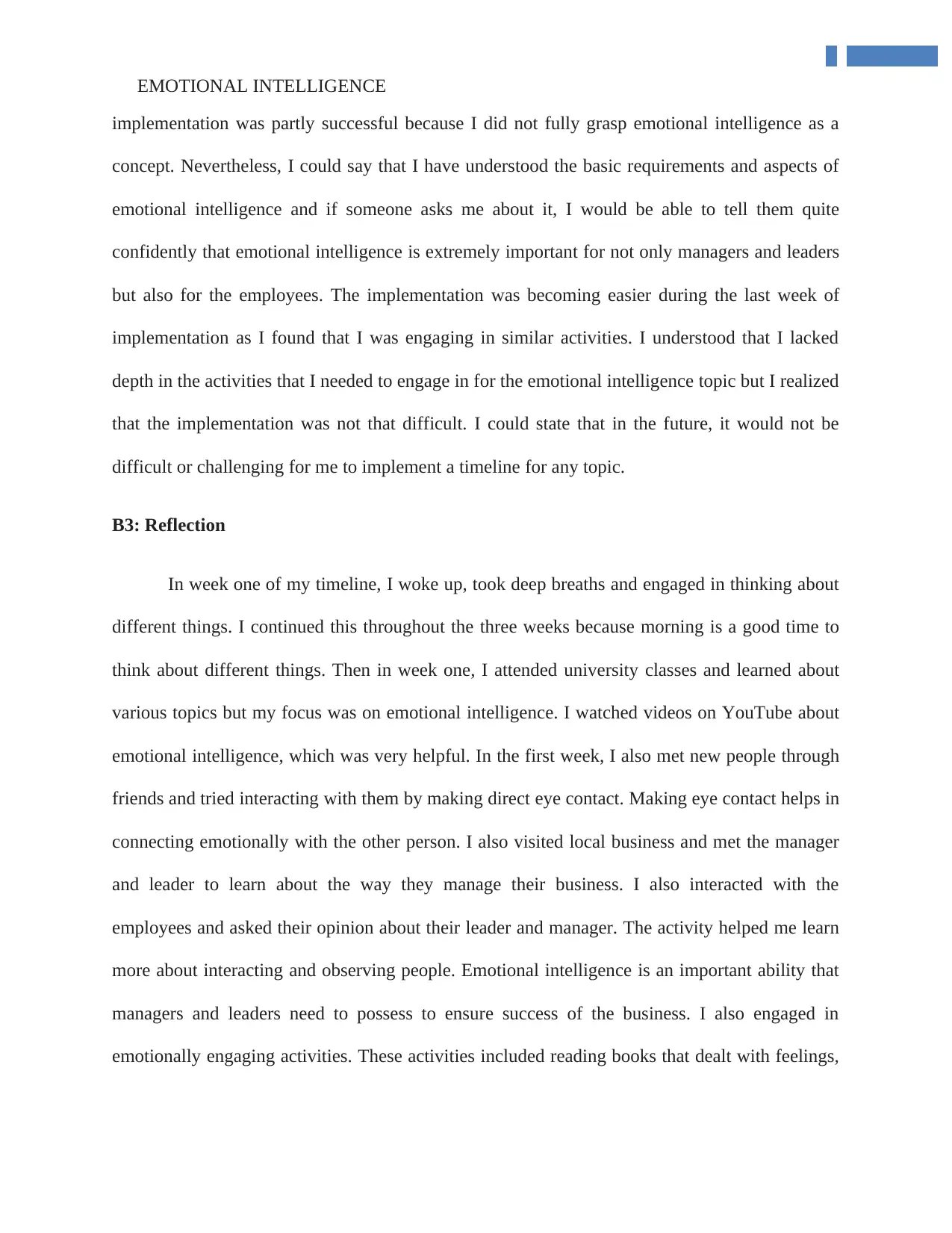
9
EMOTIONAL INTELLIGENCE
implementation was partly successful because I did not fully grasp emotional intelligence as a
concept. Nevertheless, I could say that I have understood the basic requirements and aspects of
emotional intelligence and if someone asks me about it, I would be able to tell them quite
confidently that emotional intelligence is extremely important for not only managers and leaders
but also for the employees. The implementation was becoming easier during the last week of
implementation as I found that I was engaging in similar activities. I understood that I lacked
depth in the activities that I needed to engage in for the emotional intelligence topic but I realized
that the implementation was not that difficult. I could state that in the future, it would not be
difficult or challenging for me to implement a timeline for any topic.
B3: Reflection
In week one of my timeline, I woke up, took deep breaths and engaged in thinking about
different things. I continued this throughout the three weeks because morning is a good time to
think about different things. Then in week one, I attended university classes and learned about
various topics but my focus was on emotional intelligence. I watched videos on YouTube about
emotional intelligence, which was very helpful. In the first week, I also met new people through
friends and tried interacting with them by making direct eye contact. Making eye contact helps in
connecting emotionally with the other person. I also visited local business and met the manager
and leader to learn about the way they manage their business. I also interacted with the
employees and asked their opinion about their leader and manager. The activity helped me learn
more about interacting and observing people. Emotional intelligence is an important ability that
managers and leaders need to possess to ensure success of the business. I also engaged in
emotionally engaging activities. These activities included reading books that dealt with feelings,
EMOTIONAL INTELLIGENCE
implementation was partly successful because I did not fully grasp emotional intelligence as a
concept. Nevertheless, I could say that I have understood the basic requirements and aspects of
emotional intelligence and if someone asks me about it, I would be able to tell them quite
confidently that emotional intelligence is extremely important for not only managers and leaders
but also for the employees. The implementation was becoming easier during the last week of
implementation as I found that I was engaging in similar activities. I understood that I lacked
depth in the activities that I needed to engage in for the emotional intelligence topic but I realized
that the implementation was not that difficult. I could state that in the future, it would not be
difficult or challenging for me to implement a timeline for any topic.
B3: Reflection
In week one of my timeline, I woke up, took deep breaths and engaged in thinking about
different things. I continued this throughout the three weeks because morning is a good time to
think about different things. Then in week one, I attended university classes and learned about
various topics but my focus was on emotional intelligence. I watched videos on YouTube about
emotional intelligence, which was very helpful. In the first week, I also met new people through
friends and tried interacting with them by making direct eye contact. Making eye contact helps in
connecting emotionally with the other person. I also visited local business and met the manager
and leader to learn about the way they manage their business. I also interacted with the
employees and asked their opinion about their leader and manager. The activity helped me learn
more about interacting and observing people. Emotional intelligence is an important ability that
managers and leaders need to possess to ensure success of the business. I also engaged in
emotionally engaging activities. These activities included reading books that dealt with feelings,
Secure Best Marks with AI Grader
Need help grading? Try our AI Grader for instant feedback on your assignments.
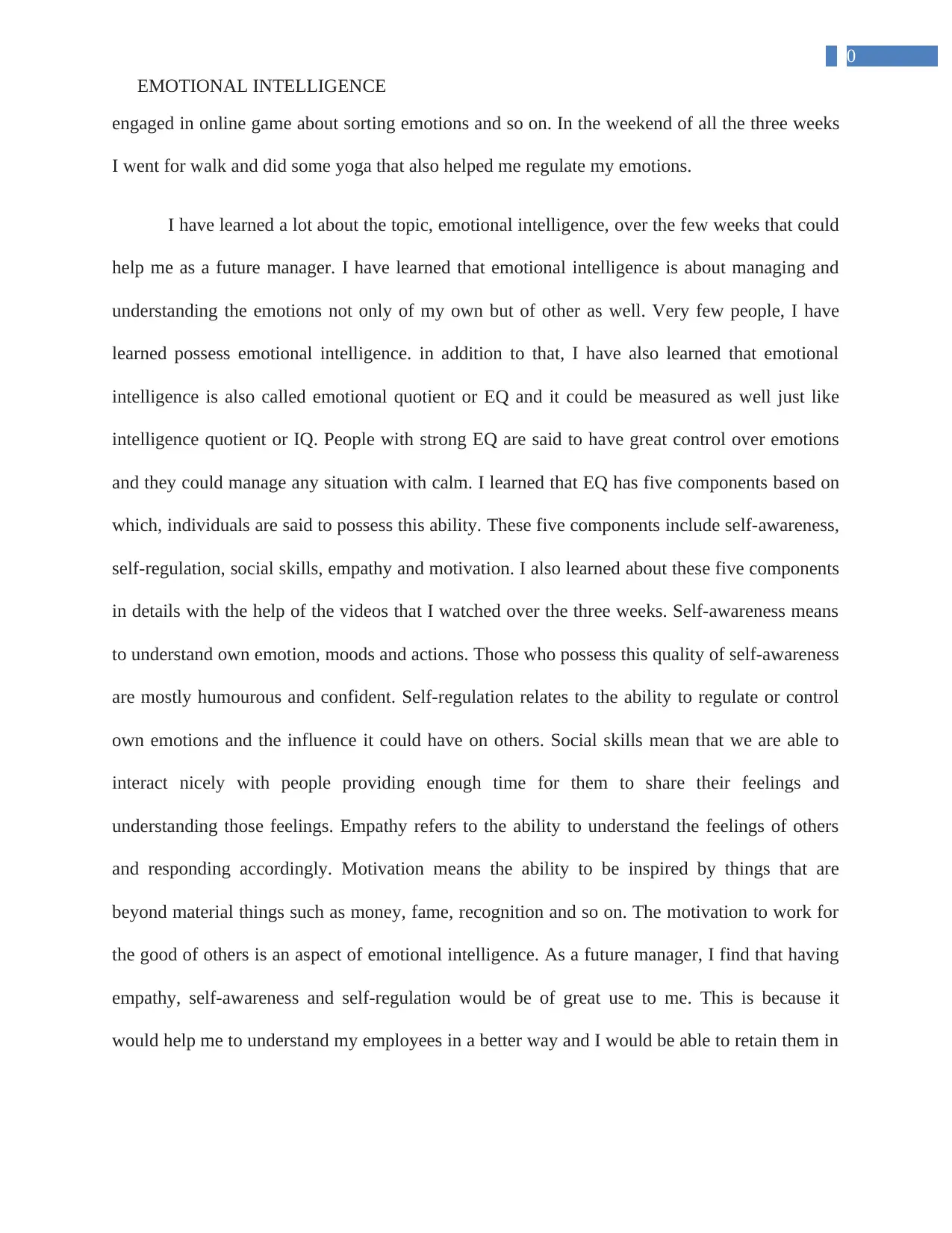
10
EMOTIONAL INTELLIGENCE
engaged in online game about sorting emotions and so on. In the weekend of all the three weeks
I went for walk and did some yoga that also helped me regulate my emotions.
I have learned a lot about the topic, emotional intelligence, over the few weeks that could
help me as a future manager. I have learned that emotional intelligence is about managing and
understanding the emotions not only of my own but of other as well. Very few people, I have
learned possess emotional intelligence. in addition to that, I have also learned that emotional
intelligence is also called emotional quotient or EQ and it could be measured as well just like
intelligence quotient or IQ. People with strong EQ are said to have great control over emotions
and they could manage any situation with calm. I learned that EQ has five components based on
which, individuals are said to possess this ability. These five components include self-awareness,
self-regulation, social skills, empathy and motivation. I also learned about these five components
in details with the help of the videos that I watched over the three weeks. Self-awareness means
to understand own emotion, moods and actions. Those who possess this quality of self-awareness
are mostly humourous and confident. Self-regulation relates to the ability to regulate or control
own emotions and the influence it could have on others. Social skills mean that we are able to
interact nicely with people providing enough time for them to share their feelings and
understanding those feelings. Empathy refers to the ability to understand the feelings of others
and responding accordingly. Motivation means the ability to be inspired by things that are
beyond material things such as money, fame, recognition and so on. The motivation to work for
the good of others is an aspect of emotional intelligence. As a future manager, I find that having
empathy, self-awareness and self-regulation would be of great use to me. This is because it
would help me to understand my employees in a better way and I would be able to retain them in
EMOTIONAL INTELLIGENCE
engaged in online game about sorting emotions and so on. In the weekend of all the three weeks
I went for walk and did some yoga that also helped me regulate my emotions.
I have learned a lot about the topic, emotional intelligence, over the few weeks that could
help me as a future manager. I have learned that emotional intelligence is about managing and
understanding the emotions not only of my own but of other as well. Very few people, I have
learned possess emotional intelligence. in addition to that, I have also learned that emotional
intelligence is also called emotional quotient or EQ and it could be measured as well just like
intelligence quotient or IQ. People with strong EQ are said to have great control over emotions
and they could manage any situation with calm. I learned that EQ has five components based on
which, individuals are said to possess this ability. These five components include self-awareness,
self-regulation, social skills, empathy and motivation. I also learned about these five components
in details with the help of the videos that I watched over the three weeks. Self-awareness means
to understand own emotion, moods and actions. Those who possess this quality of self-awareness
are mostly humourous and confident. Self-regulation relates to the ability to regulate or control
own emotions and the influence it could have on others. Social skills mean that we are able to
interact nicely with people providing enough time for them to share their feelings and
understanding those feelings. Empathy refers to the ability to understand the feelings of others
and responding accordingly. Motivation means the ability to be inspired by things that are
beyond material things such as money, fame, recognition and so on. The motivation to work for
the good of others is an aspect of emotional intelligence. As a future manager, I find that having
empathy, self-awareness and self-regulation would be of great use to me. This is because it
would help me to understand my employees in a better way and I would be able to retain them in
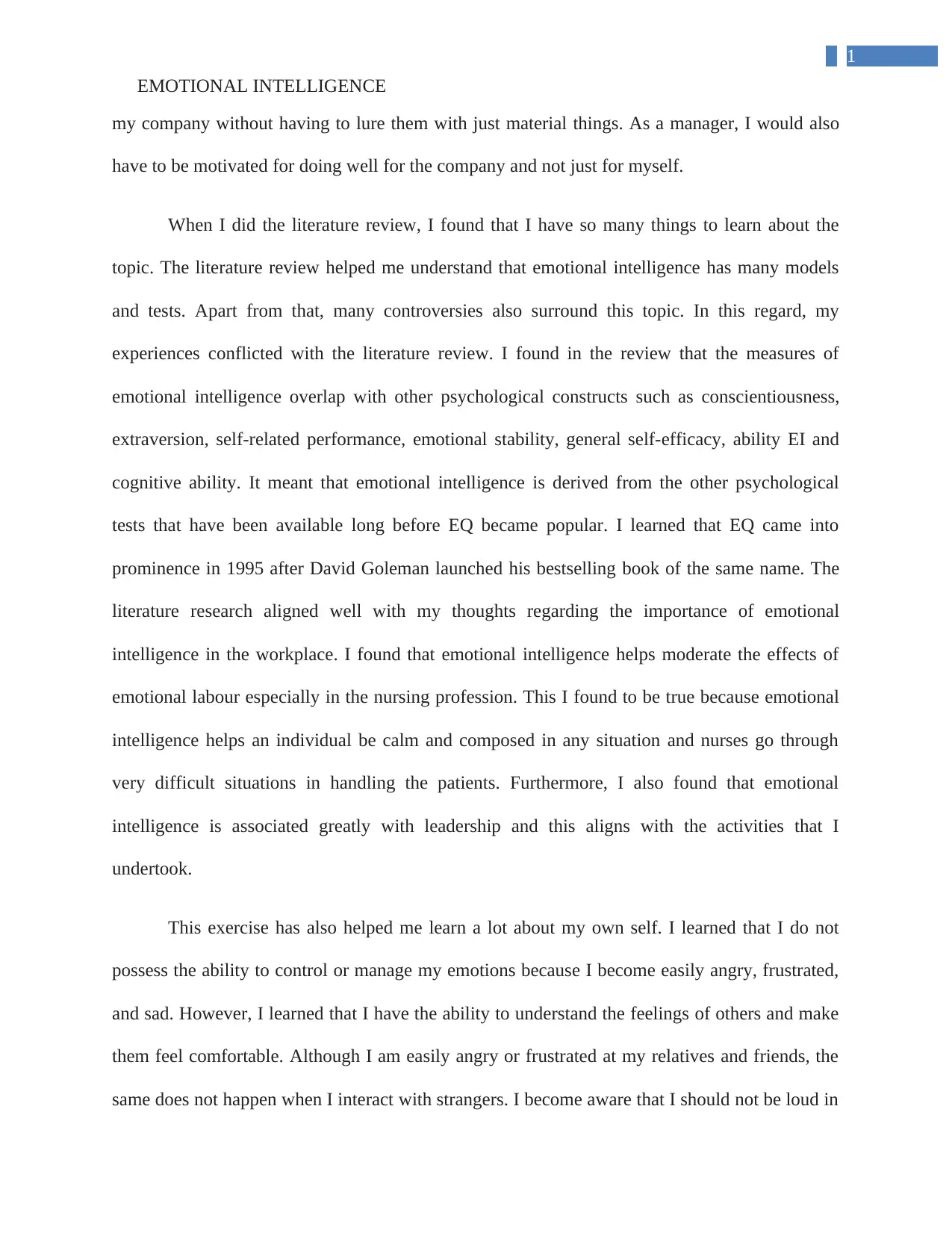
11
EMOTIONAL INTELLIGENCE
my company without having to lure them with just material things. As a manager, I would also
have to be motivated for doing well for the company and not just for myself.
When I did the literature review, I found that I have so many things to learn about the
topic. The literature review helped me understand that emotional intelligence has many models
and tests. Apart from that, many controversies also surround this topic. In this regard, my
experiences conflicted with the literature review. I found in the review that the measures of
emotional intelligence overlap with other psychological constructs such as conscientiousness,
extraversion, self-related performance, emotional stability, general self-efficacy, ability EI and
cognitive ability. It meant that emotional intelligence is derived from the other psychological
tests that have been available long before EQ became popular. I learned that EQ came into
prominence in 1995 after David Goleman launched his bestselling book of the same name. The
literature research aligned well with my thoughts regarding the importance of emotional
intelligence in the workplace. I found that emotional intelligence helps moderate the effects of
emotional labour especially in the nursing profession. This I found to be true because emotional
intelligence helps an individual be calm and composed in any situation and nurses go through
very difficult situations in handling the patients. Furthermore, I also found that emotional
intelligence is associated greatly with leadership and this aligns with the activities that I
undertook.
This exercise has also helped me learn a lot about my own self. I learned that I do not
possess the ability to control or manage my emotions because I become easily angry, frustrated,
and sad. However, I learned that I have the ability to understand the feelings of others and make
them feel comfortable. Although I am easily angry or frustrated at my relatives and friends, the
same does not happen when I interact with strangers. I become aware that I should not be loud in
EMOTIONAL INTELLIGENCE
my company without having to lure them with just material things. As a manager, I would also
have to be motivated for doing well for the company and not just for myself.
When I did the literature review, I found that I have so many things to learn about the
topic. The literature review helped me understand that emotional intelligence has many models
and tests. Apart from that, many controversies also surround this topic. In this regard, my
experiences conflicted with the literature review. I found in the review that the measures of
emotional intelligence overlap with other psychological constructs such as conscientiousness,
extraversion, self-related performance, emotional stability, general self-efficacy, ability EI and
cognitive ability. It meant that emotional intelligence is derived from the other psychological
tests that have been available long before EQ became popular. I learned that EQ came into
prominence in 1995 after David Goleman launched his bestselling book of the same name. The
literature research aligned well with my thoughts regarding the importance of emotional
intelligence in the workplace. I found that emotional intelligence helps moderate the effects of
emotional labour especially in the nursing profession. This I found to be true because emotional
intelligence helps an individual be calm and composed in any situation and nurses go through
very difficult situations in handling the patients. Furthermore, I also found that emotional
intelligence is associated greatly with leadership and this aligns with the activities that I
undertook.
This exercise has also helped me learn a lot about my own self. I learned that I do not
possess the ability to control or manage my emotions because I become easily angry, frustrated,
and sad. However, I learned that I have the ability to understand the feelings of others and make
them feel comfortable. Although I am easily angry or frustrated at my relatives and friends, the
same does not happen when I interact with strangers. I become aware that I should not be loud in

12
EMOTIONAL INTELLIGENCE
front of them and should control my emotions. Another thing that I noticed about myself through
this exercise is that I am very poor in time management and implementation of plans. While
preparing and implementing the timeline, I was very confused as to what I should do and I easily
became frustrated. Due to the frustration, I was not able to control other activities initially.
However, engaging in mediation helped a lot in taking away the frustration and increasing my
concentration.
I think the lessons that are critical for managers and employees to learn from emotional
intelligence are the ability to control and manage the emotions of self and others, have social
awareness and skills and empathy. Many experts have suggested that emotional intelligence or
EQ is more important than even IQ although this might be debated. However, it is true that
emotional intelligence plays a huge role in retaining employees in organizations. It is not
possible to retain employees with only strong IQ and materialistic rewards. The managers must
be empathetic towards the employees because a lack of empathy makes the manager narcissistic,
that is, concerned about her or his own interests only. This makes the employees hate the
managers because such managers would only think about production and profit and not about the
overall wellbeing of the employees. In case of employees, the critical lesson that emotional
intelligence teaches is that they should have the skills to deal or interact with others effectively.
In addition, they must also have the ability to control their emotions and compose themselves
even in the toughest situations. When they will be able to have these abilities, it will be easier for
them to handle any situation and any manager even if the manager is a narcissist. It is also
important to note that many jobs are very demanding especially emotionally including the
nursing job. The employees have to face many situations where they have to deal with the anger
and other emotions of the customers or patients in case of nurses. In such situations, possessing
EMOTIONAL INTELLIGENCE
front of them and should control my emotions. Another thing that I noticed about myself through
this exercise is that I am very poor in time management and implementation of plans. While
preparing and implementing the timeline, I was very confused as to what I should do and I easily
became frustrated. Due to the frustration, I was not able to control other activities initially.
However, engaging in mediation helped a lot in taking away the frustration and increasing my
concentration.
I think the lessons that are critical for managers and employees to learn from emotional
intelligence are the ability to control and manage the emotions of self and others, have social
awareness and skills and empathy. Many experts have suggested that emotional intelligence or
EQ is more important than even IQ although this might be debated. However, it is true that
emotional intelligence plays a huge role in retaining employees in organizations. It is not
possible to retain employees with only strong IQ and materialistic rewards. The managers must
be empathetic towards the employees because a lack of empathy makes the manager narcissistic,
that is, concerned about her or his own interests only. This makes the employees hate the
managers because such managers would only think about production and profit and not about the
overall wellbeing of the employees. In case of employees, the critical lesson that emotional
intelligence teaches is that they should have the skills to deal or interact with others effectively.
In addition, they must also have the ability to control their emotions and compose themselves
even in the toughest situations. When they will be able to have these abilities, it will be easier for
them to handle any situation and any manager even if the manager is a narcissist. It is also
important to note that many jobs are very demanding especially emotionally including the
nursing job. The employees have to face many situations where they have to deal with the anger
and other emotions of the customers or patients in case of nurses. In such situations, possessing
Paraphrase This Document
Need a fresh take? Get an instant paraphrase of this document with our AI Paraphraser
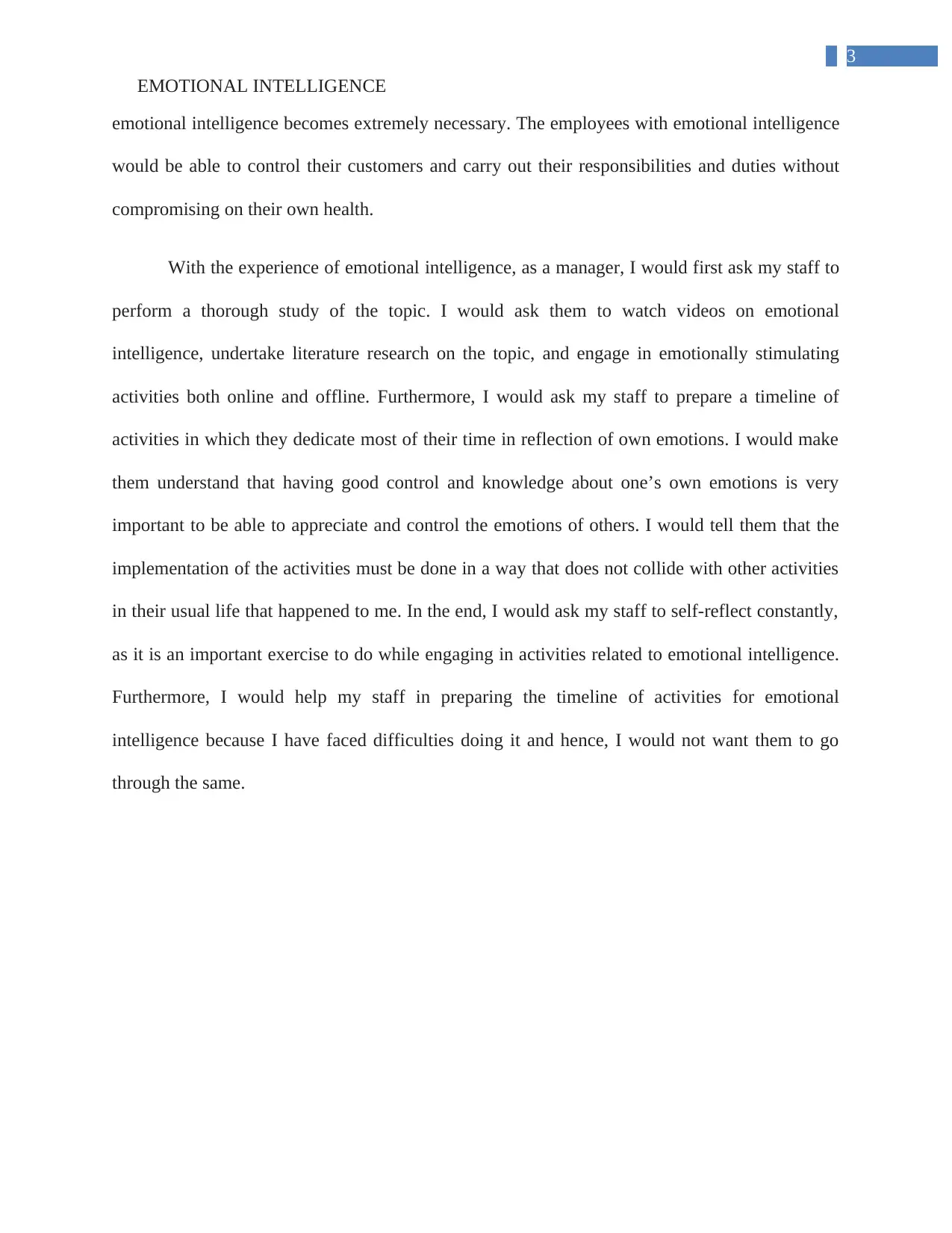
13
EMOTIONAL INTELLIGENCE
emotional intelligence becomes extremely necessary. The employees with emotional intelligence
would be able to control their customers and carry out their responsibilities and duties without
compromising on their own health.
With the experience of emotional intelligence, as a manager, I would first ask my staff to
perform a thorough study of the topic. I would ask them to watch videos on emotional
intelligence, undertake literature research on the topic, and engage in emotionally stimulating
activities both online and offline. Furthermore, I would ask my staff to prepare a timeline of
activities in which they dedicate most of their time in reflection of own emotions. I would make
them understand that having good control and knowledge about one’s own emotions is very
important to be able to appreciate and control the emotions of others. I would tell them that the
implementation of the activities must be done in a way that does not collide with other activities
in their usual life that happened to me. In the end, I would ask my staff to self-reflect constantly,
as it is an important exercise to do while engaging in activities related to emotional intelligence.
Furthermore, I would help my staff in preparing the timeline of activities for emotional
intelligence because I have faced difficulties doing it and hence, I would not want them to go
through the same.
EMOTIONAL INTELLIGENCE
emotional intelligence becomes extremely necessary. The employees with emotional intelligence
would be able to control their customers and carry out their responsibilities and duties without
compromising on their own health.
With the experience of emotional intelligence, as a manager, I would first ask my staff to
perform a thorough study of the topic. I would ask them to watch videos on emotional
intelligence, undertake literature research on the topic, and engage in emotionally stimulating
activities both online and offline. Furthermore, I would ask my staff to prepare a timeline of
activities in which they dedicate most of their time in reflection of own emotions. I would make
them understand that having good control and knowledge about one’s own emotions is very
important to be able to appreciate and control the emotions of others. I would tell them that the
implementation of the activities must be done in a way that does not collide with other activities
in their usual life that happened to me. In the end, I would ask my staff to self-reflect constantly,
as it is an important exercise to do while engaging in activities related to emotional intelligence.
Furthermore, I would help my staff in preparing the timeline of activities for emotional
intelligence because I have faced difficulties doing it and hence, I would not want them to go
through the same.
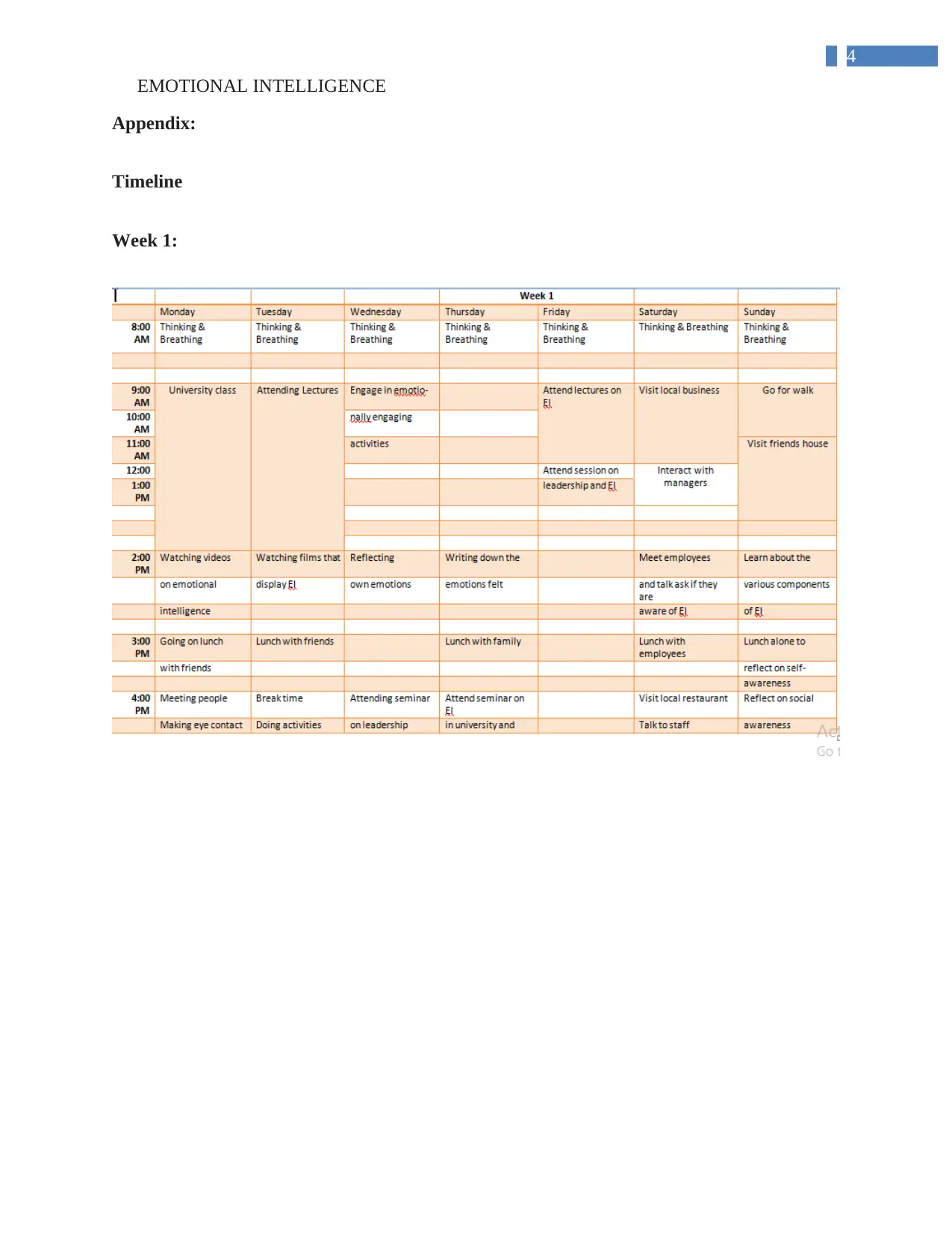
14
EMOTIONAL INTELLIGENCE
Appendix:
Timeline
Week 1:
EMOTIONAL INTELLIGENCE
Appendix:
Timeline
Week 1:
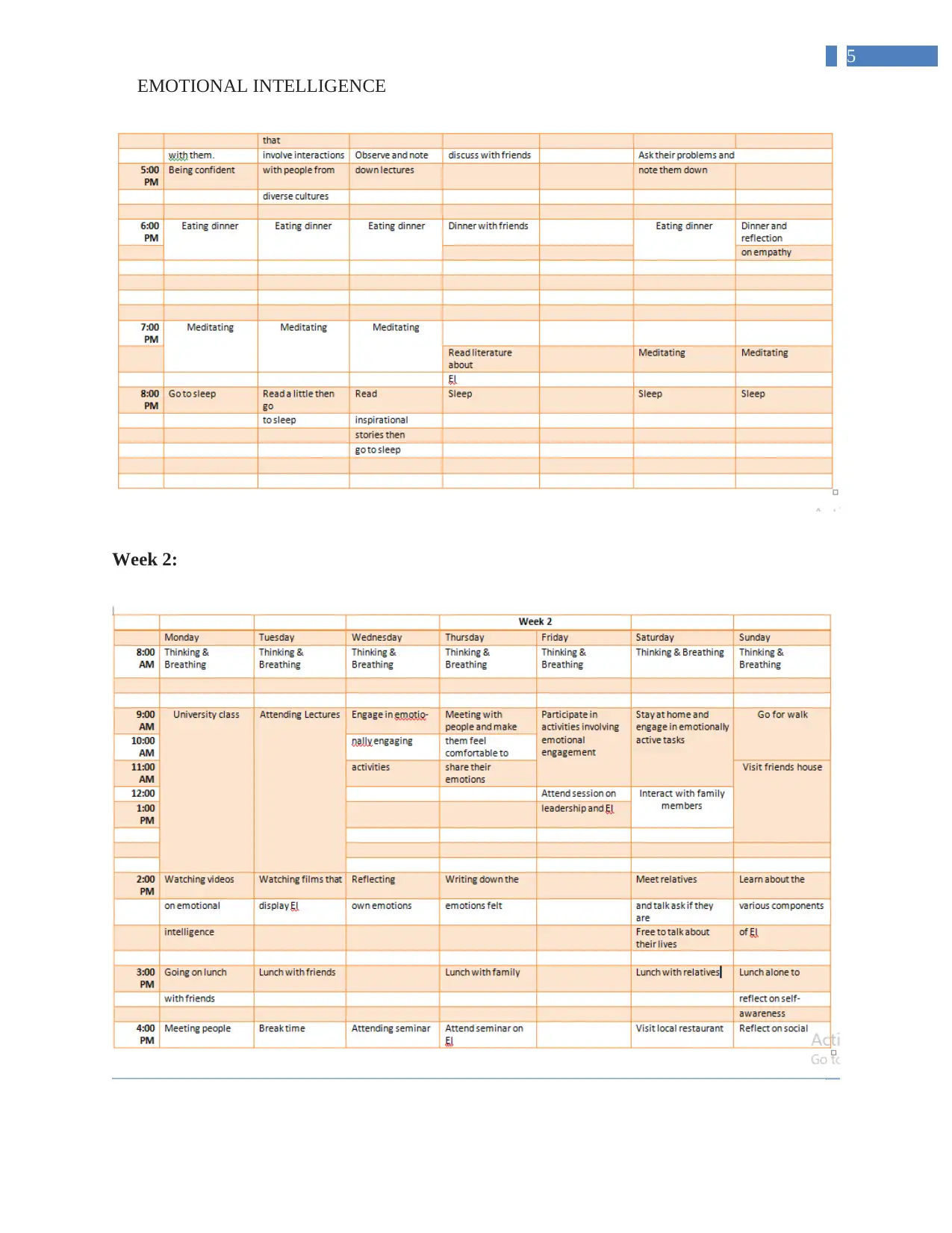
15
EMOTIONAL INTELLIGENCE
Week 2:
EMOTIONAL INTELLIGENCE
Week 2:
Secure Best Marks with AI Grader
Need help grading? Try our AI Grader for instant feedback on your assignments.
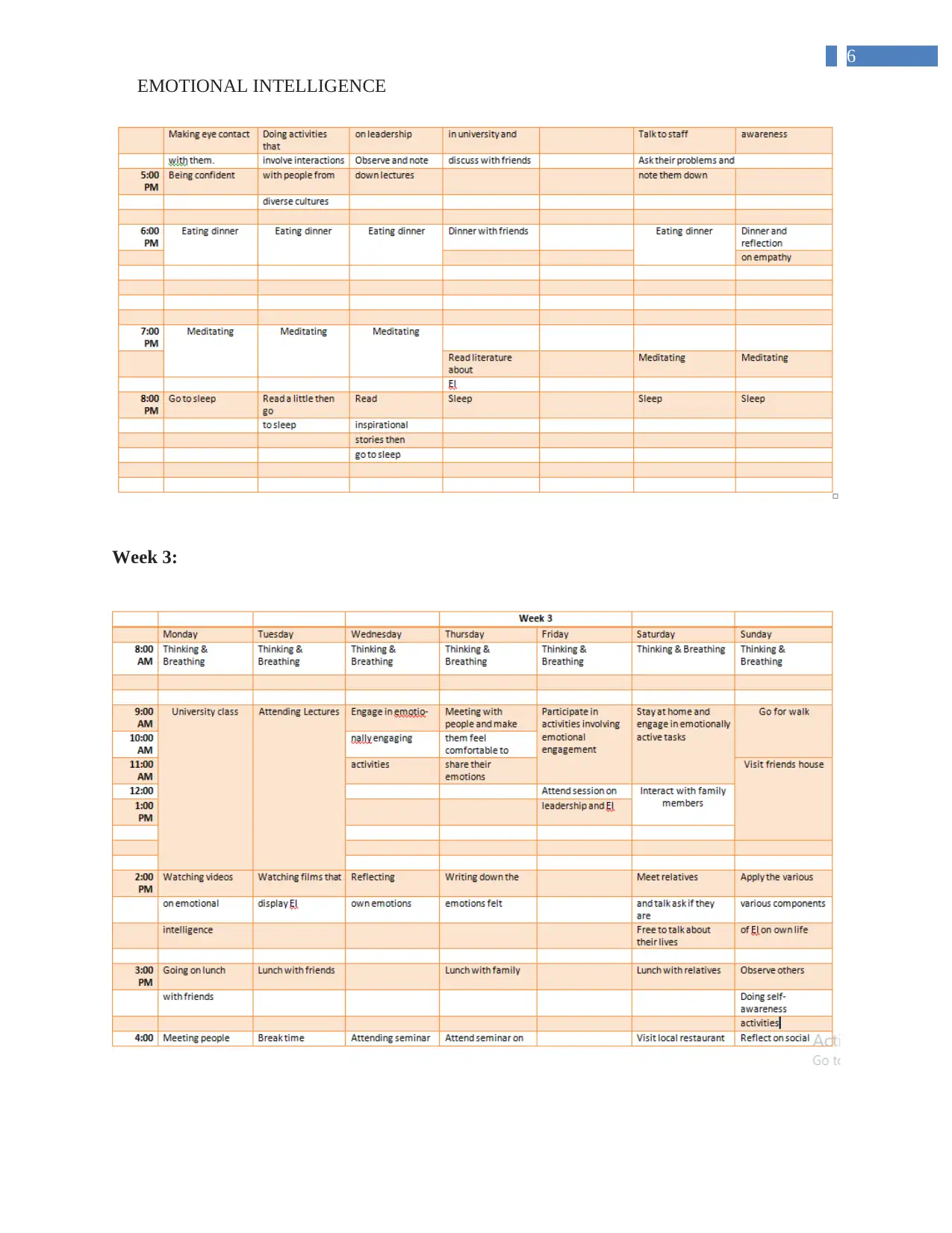
16
EMOTIONAL INTELLIGENCE
Week 3:
EMOTIONAL INTELLIGENCE
Week 3:
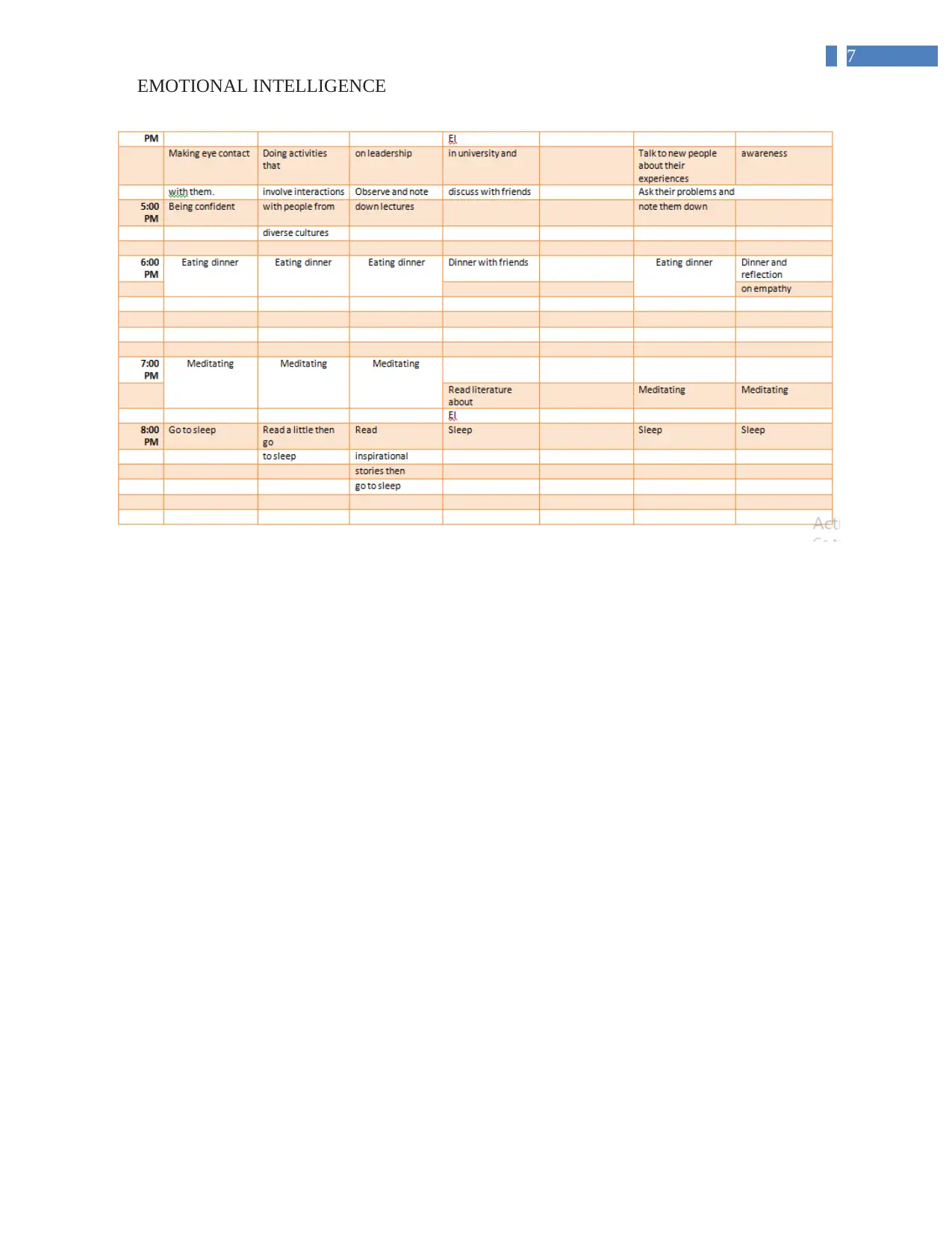
17
EMOTIONAL INTELLIGENCE
EMOTIONAL INTELLIGENCE
1 out of 18
Related Documents
Your All-in-One AI-Powered Toolkit for Academic Success.
+13062052269
info@desklib.com
Available 24*7 on WhatsApp / Email
![[object Object]](/_next/static/media/star-bottom.7253800d.svg)
Unlock your academic potential
© 2024 | Zucol Services PVT LTD | All rights reserved.




